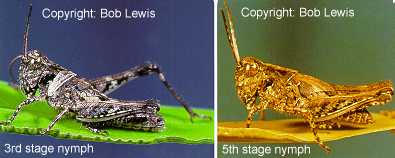Nymph description 10 of 15

Distribution

Nymph Description: Colour is dark brown to almost black, sometimes green. In early instars there is a very pronounced white stripe on the side from the front of the head below the eye to mid thorax at a 45 degree angle. In later instars the stripe stays along the head but becomes less distinct on the thorax which develops a strong light collar along its back edge. In grey-brown individuals the stripe is whitish while in green ones it is a lighter green. The legs and underside of the body have a visible layer of hair. The antennae are slightly longer than the head is high and are dark with a light tip. The hind femur is banded with a strong single band in early instars but less distinct in later ones. The rear tibia are dark with a light top quarter.
Confusion with Australian plague locust and Austroicetes: General shape, markings and size are very similar but they lack the 'X' mark on top of the thorax.
Unique features: The combination of the long dark antennae with a light tip, hairy legs and underside of body, with the light stripe on the lower face and light collar along the rear of the thorax, and no 'X' mark on top of the thorax.
Further information on this species: Description of adult
